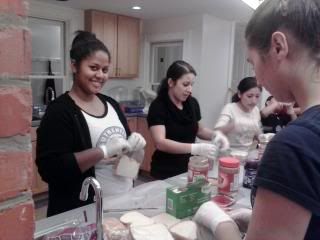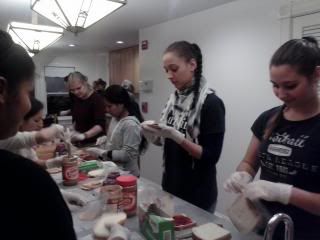In the spirit of Thanksgiving and sharing, our au pairs came together to make over 300 sandwiches for DC Central Kitchen. I would also like to thank the Seekers Church in Takoma Park for allowing us to use their space for a very reasonable cost.
Monthly Archives: November 2013
November 24-30 is National Game and Puzzle Week
 Most children love to play games – ball games, card games, board games, word games, guessing games. Playing games is important because it helps children learn how to handle disappointment when they lose. It also helps them to learn to take turns and how to follow rules. Play their favorites or teach them a new game from your childhood.
Most children love to play games – ball games, card games, board games, word games, guessing games. Playing games is important because it helps children learn how to handle disappointment when they lose. It also helps them to learn to take turns and how to follow rules. Play their favorites or teach them a new game from your childhood.
Check out a selection of games from around the world HERE on the Global Awareness website.
Photo: viZZZual.com (Flickr)
Dressing for Winter Weather
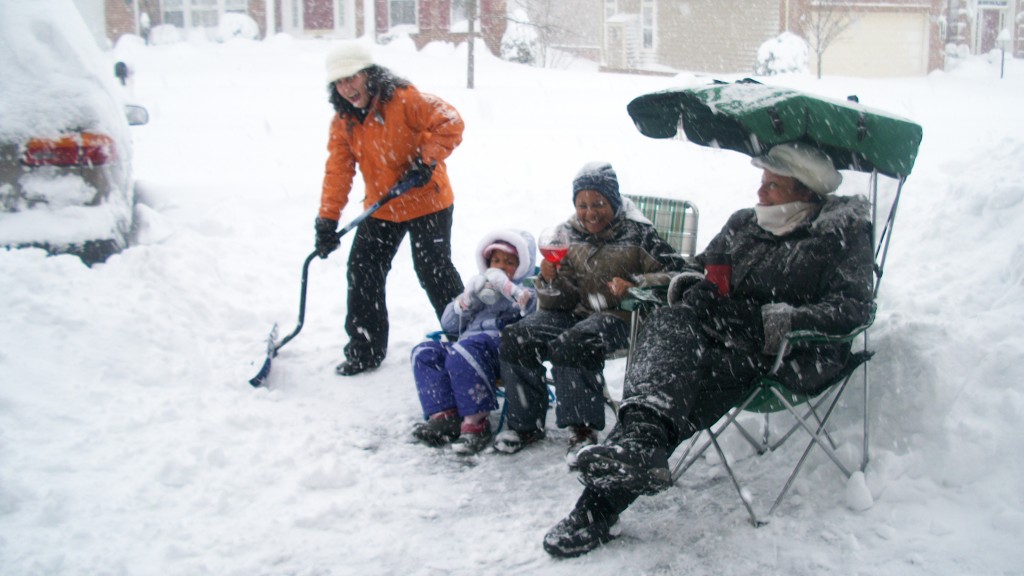
This is a picture from 2010, Sandra and her host family out in the snow.
In our area it will be cold most of the winter and there could be snow, any time from now through March. If you have not already bought a coat, hat, gloves and boots, you will wish that you had.
It does snow in Maryland and the host parents do expect that you will be outside rolling in the white stuff with the kids. Because we don’t get as much snow as the Alps — we freak out a little here when it does snow. School will be canceled for only one inch of snow. The girls from Germany and Austria will laugh. The kids get soooo excited by this event they will want to stay outside and use every inch of snow in the yard to build a snowman. We also have a cluster snow tubing trip coming up in the new year, you want to be prepared to join in the fun and stay warm.
There are a lot of great sales going on, look for coats and cold weather accessories. Some cheap options are: Ross, TJ Maxx, Marshalls, Burlington Coat Factory, WalMart and Kohl’s. An even more affordable option would be to go to a thrift shop. There are many in the area and you can often find a very warm jacket for a small price compared to buying one new.
Dress in Layers – Consider buying sweaters, lightweight jackets and long underwear. If you wear several layers, you can take off things to be comfortable. For example when it might be too warm for a heavy jacket, but too cold for just a sweater, you can combine different pieces of clothing.
Set a Good Example – it is the expectation of most host parents that you set the example for your kids and you wear a coat when it is cold outside. You should have a winter coat, hats, gloves, boots and scarves. Your kids will fight wearing a coat if you don’t wear one. Think of yourself as a celebrity and everyone wants to look like you — especially your kids.
Check the “Emergency Change of Clothes” – With young children, we often keep an emergency change of clothes in the car, diaper bag or at their school. If you haven’t already switched out the shorts and t-shirt for something warmer, this would be a good idea.
Get yourself some warm winter clothes now. Prepare for the snow!
Garland of Gratitude Craft
Below are the directions from Spoonful for this fun and easy project.
Garland of Gratitude
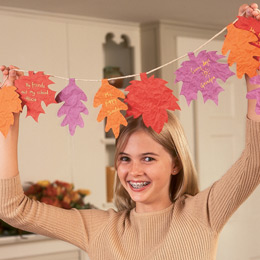
Simple enough for kids to create on their own, these beautiful, textured leaves make a wonderful holiday tradition. Invite each guest to write something he or she is grateful for on a leaf, and watch the garland grow each year.
- Materials
- Colored construction paper
- Pencil
- Spray bottle (filled with water)
- Scissors
- Colored pencils
- Twine or natural-colored string
- Double-sided tape
- Instructions
-
- Draw leaf shapes on colored construction paper, or download leaf templates and then trace on to colored construction paper.Make at least 1 leaf per guest plus others for decoration.
- Lay the paper on a covered work surface, then spray water over both sides so the whole surface is damp. Crumple the paper into a loose ball, flatten it out, and let it dry completely (which takes a few hours).
- Next, cut out the leaves and hand them to your guests to write on.
- Finally, make a garland by folding the stems over a length of string and taping them in place. Drape them from a sideboard, along a mantel, or from the top of a doorway.
I am Thankful for…
Notice the first thing on this little boy’s list of things he is thankful for. 🙂
Clearly, he must have a fantastic au pair!
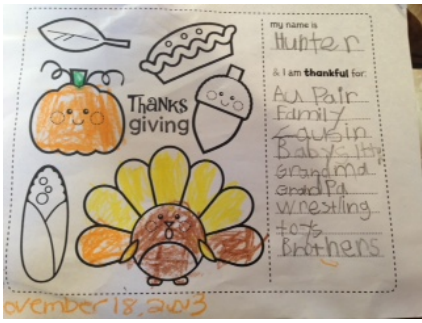
Happy Thanksgiving! I hope you have lots to be thankful for too.
Countdown Calender – Adventkalender
I wanted to share this special post written by an au pair in my cluster a few years ago. If you want to make an Advent calendar for your host child(ren) you should probably get started now.
A post by special guest blogger, Alex from Austria:
Countdown calender – Adventkalender
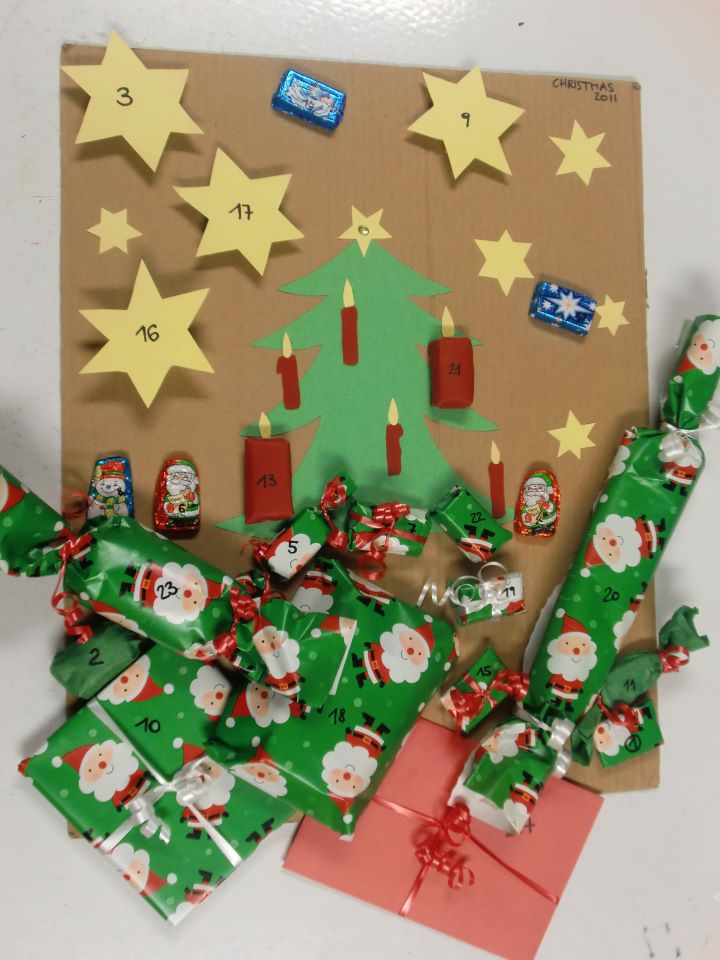
The Christmas countdown starts on December 1! 
To make it sweeter, funnier and not that long for kids, we in Austria (guess so in Germany too) have an “Adventkalender.” That is a calender with 24 little gifts (mostly sweets) and you can open one number every day till the 24th of December!
I always love that and my mom still buys one for me, so I want to share that tradition with my hostchild!
The easiest way is to go to the shop and buy a ready made one with small little chocolate treats, but of course it is more fun for the kids to get a homemade one! I did that this year and it was fun for me too!
- I bought some sweets and small presents like a pen, warm socks, a cd or a toy (–> go to dollar tree, you can find cute stuff there and just for $1 ) and wrapped them into paper.
- Then write the 24 numbers on the little gifts.
- You can also make a number 25, but we in Austria open our presents on the 24th.
- I pinned my packages on a big carton that we can hang the calender on the wall and decorated it!
I made a Christmas tree with all the packages under it and some stars, but you can make something else too. Maybe a snowman and the gifts all look like snowflakes or what about the crib with mary and the baby and the stars are the gifts.. Whatever you want! – be creative and make an awesome Adventkalender! 
It is very easy and it does not take very long and I guess it is a really nice gift for my little girl!
Try it too, I bet the kids love it 
Have fun and Frohe Weihnachten (Merry Christmas)
Alex 🙂
What to Do After a Car Accident
 Having a car accident is a very upsetting, stressful situation. Being prepared and knowing what to do can make things a little bit easier. Make sure you know which host parent to call in case of an accident.
Having a car accident is a very upsetting, stressful situation. Being prepared and knowing what to do can make things a little bit easier. Make sure you know which host parent to call in case of an accident.
Make sure you have all the necessary documents in your car glove box. Read this post on What to Keep in the Car Glove Box for a detailed list.
If you have an accident: (from Edmunds.com)
- Keep Safety First. Drivers involved in minor accidents with no serious injuries should move cars to the side of the road and out of the way of oncoming traffic. Leaving cars parked in the middle of the road or busy intersection can result in additional accidents and injuries. If a car cannot be moved, drivers and passengers should remain in the cars with seatbelts fastened for everyone’s safety until help arrives. Make sure to turn on hazard lights and set out cones, flares or warning triangles if possible.
- Exchange Information. After the accident, exchange the following information: name, address, phone number, insurance company, policy number, driver license number and license plate number for the driver and the owner of each vehicle. If the driver’s name is different from the name of the insured, establish what the relationship is and take down the name and address for each individual. Also make a written description of each car, including year, make, model and color — and the exact location of the collision and how it happened. Finally, be polite but don’t tell the other drivers or the police that the accident was your fault, even if you think it was.
- Photograph and Document the Accident. Use your camera to document the damage to all the vehicles. Keep in mind that you want your photos to show the overall context of the accident so that you can make your case to a claims adjuster. If there were witnesses, try to get their contact information; they may be able to help you if the other drivers dispute your version of what happened.
Daylight Saving Time Ends This Weekend

Daylight Saving Time
During DST, clocks are turned forward an hour, effectively moving an hour of daylight from the morning to the evening. Today, approximately 70 countries worldwide utilize Daylight Saving Time in at least some portion of the country. If you don’t come from one of those countries, I am guessing that the idea may seem strange.
Spring Forward, Fall Back
Most of the United States begins Daylight Saving Time at 2:00 a.m. on the second Sunday in March and reverts to standard time on the first Sunday in November. In the U.S., each time zone switches at a different time.
What do I do?
Enjoy an extra hour of sleep. In the fall, we get back the hour that we lost in the spring. Although, the official change occurs at 2 am, you can turn your clock back one hour before you go to bed on Saturday night.
A Safety Reminder
Many fire departments encourage people to change the batteries in their smoke detectors when they change their clocks because Daylight Saving Time provides a convenient reminder. “A working smoke detector more than doubles a person’s chances of surviving a home fire,” says William McNabb of the Troy Fire Department in Michigan. More than 90 percent of homes in the United States have smoke detectors, but one-third are estimated to have dead or missing batteries.
Information from webexhibits.org


